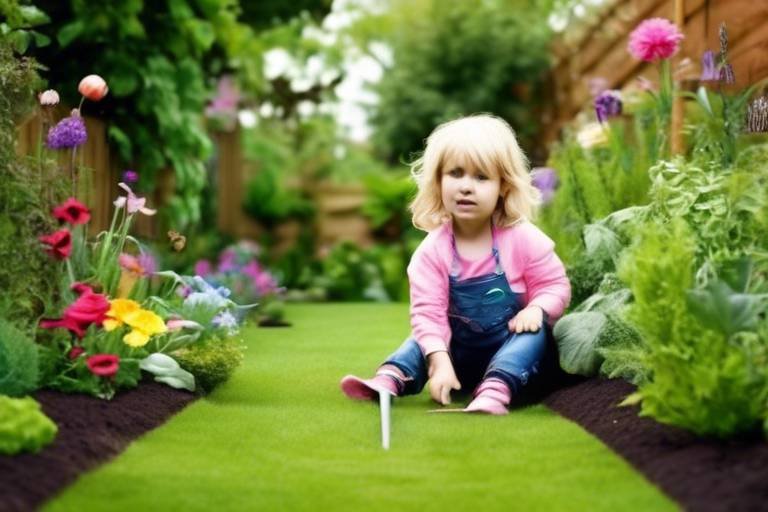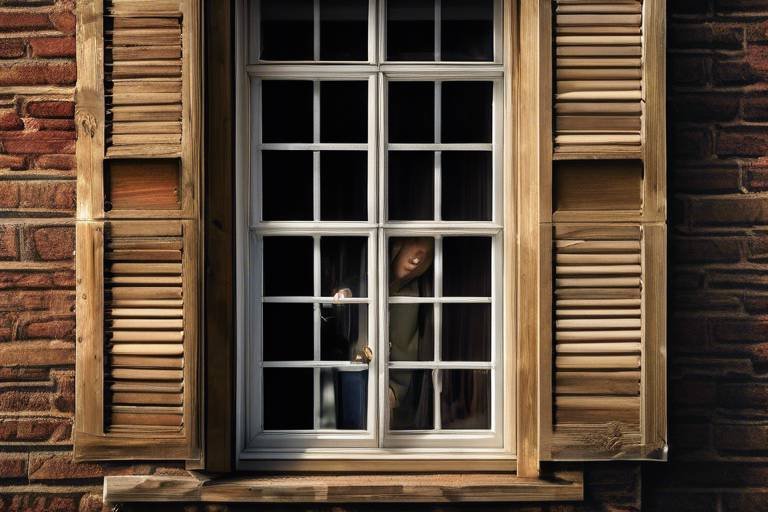How to Make Your Garden Child-Safe
Creating a child-safe garden involves careful planning and execution. It's not just about planting pretty flowers or growing vegetables; it's about ensuring that your outdoor space is a haven for your little ones. Imagine a vibrant garden where children can play freely, explore nature, and learn about plants without the looming threat of hazards. This article explores essential strategies to ensure your outdoor space is secure, enjoyable, and free from dangers for children. From assessing potential hazards to choosing the right plants and creating safe play areas, we’ll cover everything you need to know to make your garden a safe paradise for your kids.
Identifying hazards in your garden is the first step towards creating a safe environment for children. Think of your garden as a treasure map; you want to mark all the dangerous spots before your little adventurers start exploring. Common dangers can include:
- Sharp tools: Gardening tools can be dangerous if left lying around. Always store them out of reach.
- Poisonous plants: Some plants can be toxic if ingested. Knowing which ones to avoid is crucial.
- Uneven surfaces: Potholes, rocks, and other uneven ground can lead to trips and falls.
By taking the time to assess these hazards, you can make informed decisions about how to mitigate risks and create a safer space for your children.
Selecting the right plants is crucial for safety. Not all plants are created equal, and some can pose serious health risks to children. Here, we will review child-friendly plants and those that should be avoided due to toxicity or sharp thorns. It's like selecting the right ingredients for a recipe; you want to ensure everything is safe and delicious!
This subsection highlights a variety of non-toxic plants that are safe for children. Incorporating these options can enhance your garden's beauty while ensuring safety. Some great choices include:
- Sunflowers: Bright and cheerful, these giants are safe and fun for kids to grow.
- Marigolds: Not only do they add a splash of color, but they're also non-toxic!
- Snapdragons: These whimsical flowers are safe and can provide hours of imaginative play.
By choosing non-toxic plants, you create a beautiful landscape without compromising safety.
Growing edible plants is a fun way to engage children in gardening. Kids love to dig in the dirt, and what could be more rewarding than eating what they’ve grown? Some safe edible options include:
- Carrots: Easy to grow and deliciously crunchy!
- Strawberries: Sweet, juicy, and perfect for snacking.
- Radishes: Quick to sprout and fun to harvest.
In addition to edible options, decorative non-toxic plants can also beautify your garden. Think of them as the finishing touches on a masterpiece. Some visually appealing and safe plants include:
- Pansies: These colorful blooms add charm and are completely safe.
- Petunias: Bright and cheerful, they are perfect for borders or hanging baskets.
Some plants can be harmful to children. This part will identify common toxic plants that should be removed or avoided in child-safe gardens. For example, oleander and foxglove are beautiful but can be deadly if ingested. Always do your research before planting to ensure your garden remains a safe space.
Designing dedicated play areas can provide children with safe spaces to explore. Think of these zones as the playgrounds of your garden, where imagination can run wild without the worries of hidden dangers. To create fun and secure play zones, consider the following:
Choosing the right ground cover can minimize injury risks. Instead of hard surfaces that can lead to bumps and bruises, think of options like:
- Grass: A natural cushion for falls.
- Mulch: Soft and safe, it also helps with drainage.
- Rubber mats: Durable and designed for safety.
Incorporating play equipment requires safety considerations. When selecting playground equipment, look for sturdy materials, age-appropriate designs, and regular maintenance. It's like choosing a car; you want something reliable that keeps your kids safe while they have fun.
Establishing clear boundaries is essential for child safety. Think of fencing as the protective barrier that keeps your little explorers safe while they enjoy their outdoor adventures. This section will discuss various fencing options and how to effectively secure your garden.
Different types of fencing serve various purposes. Consider options like:
- Wooden fencing: Classic and sturdy.
- Vinyl fencing: Low maintenance and durable.
- Metal fencing: Strong and secure.
Choosing the right type of fencing can help keep your children safely within the bounds of your garden.
Controlling access points is vital for safety. Consider how to manage gates and entrances to prevent unauthorized access to potentially dangerous areas. A locked gate is like a safety net; it keeps your little ones safe while allowing you peace of mind.
Supervision is key in a child-safe garden. It's not just about having a safe space; it’s about being present and aware. This section emphasizes the importance of adult supervision and educating children about garden safety. After all, knowledge is power!
Educating children about garden safety can prevent accidents. Effective ways to teach kids the dos and don'ts of playing in the garden include:
- Setting clear rules: Make sure they know what is safe and what isn’t.
- Modeling safe behavior: Show them how to handle tools and plants properly.
Promoting responsible play habits helps children understand boundaries. Techniques to encourage safe and respectful behavior in the garden can include:
- Regular check-ins: Make sure they know you’re nearby.
- Positive reinforcement: Praise them when they follow the rules.
Q: What are the best plants to include in a child-safe garden?
A: Non-toxic plants like sunflowers, marigolds, and snapdragons are great choices. Edible plants such as strawberries and carrots are also fun for kids to grow.
Q: How can I make my garden safer for children?
A: Assess potential hazards, choose safe plants, create soft play areas, and ensure proper supervision.
Q: Should I remove any existing plants?
A: Yes, if you have toxic plants like oleander or foxglove, it's best to remove them for safety.

Assessing Potential Hazards
Creating a child-safe garden involves careful planning and execution. This article explores essential strategies to ensure your outdoor space is secure, enjoyable, and free from hazards for children.
Identifying hazards in your garden is the first step toward creating a safe environment for children. Just like a detective on a mission, you need to scrutinize every corner of your garden for potential dangers. Think about it: your garden is a playground of possibilities, but it can also harbor hidden threats that could cause accidents. Common hazards include sharp tools, poisonous plants, and uneven surfaces that might trip little feet.
First and foremost, let's talk about sharp tools. Gardening tools like shovels, rakes, and shears can be hazardous if left lying around. A curious child might pick one up, thinking it’s a toy, which could lead to serious injuries. Therefore, it’s essential to store these tools in a locked shed or a high place out of reach when not in use.
Next, consider the plants in your garden. While flowers and greenery can add beauty, some plants are toxic and can pose a significant risk to children. For instance, plants like oleander, foxglove, and lily of the valley can be extremely poisonous if ingested. It’s vital to research and identify any potentially harmful plants in your garden. If you’re unsure, consult a local gardening expert or refer to reliable online resources.
Uneven surfaces can also be a hidden danger. Children are naturally energetic and adventurous, often running and playing without a care in the world. If your garden has uneven paths, rocks, or holes, it increases the risk of trips and falls. To mitigate this risk, consider leveling out the ground, filling in holes, and ensuring that pathways are clear and safe for little ones to navigate.
In addition to these hazards, it’s important to be aware of the presence of pesticides and chemicals. Many gardeners use these substances to keep pests at bay, but they can be harmful to children. Always opt for child-safe and environmentally friendly alternatives. If you must use chemicals, ensure that they are stored securely and that children are kept away from treated areas until it is safe.
To summarize, here’s a quick checklist of potential hazards to assess in your garden:
- Sharp tools: Store securely and out of reach.
- Toxic plants: Identify and remove harmful species.
- Uneven surfaces: Level ground and clear pathways.
- Pesticides and chemicals: Use child-safe alternatives and store securely.
By taking the time to assess these potential hazards, you’re setting the stage for a garden that’s not only beautiful but also a safe haven for children to explore and enjoy. Remember, the goal is to create an environment where imagination can flourish without the worry of injury lurking around every corner.
Q: What are some common toxic plants to avoid in a child-safe garden?
A: Some common toxic plants include oleander, foxglove, and lily of the valley. Always research plants before adding them to your garden.
Q: How can I make my garden safer for children?
A: Start by assessing potential hazards, choosing non-toxic plants, creating safe play areas, and ensuring adult supervision.
Q: What type of ground cover is best for children's play areas?
A: Soft ground cover options like grass, mulch, or rubber mats can minimize injury risks while providing a comfortable play surface.
Q: How often should I check for hazards in my garden?
A: Regularly inspect your garden, especially after storms or heavy winds, as these can uncover new hazards.

Choosing Safe Plants
When it comes to creating a child-safe garden, one of the most crucial aspects is selecting the right plants. Not only do you want your garden to look beautiful, but you also want it to be a safe environment for children to explore and play. Imagine your little ones running around, picking flowers, and discovering the wonders of nature without a care in the world—this is what a child-friendly garden can offer! However, it’s essential to be vigilant about the types of plants you include in your outdoor space. Some plants can be harmful, while others can enhance the beauty of your garden without posing any risks.
To make the right choices, consider the following categories of plants:
- Non-Toxic Plant Options: These are plants that are safe for children to touch and even taste. Incorporating non-toxic plants not only ensures safety but also adds a vibrant touch to your garden.
- Edible Plants: Growing edible plants can be a delightful way to involve children in gardening. They can learn about where food comes from while enjoying the fruits of their labor.
- Decorative Plants: Aesthetics matter! Choosing beautiful, non-toxic plants can create an inviting atmosphere while keeping safety in mind.
- Plants to Avoid: It’s just as important to know what to keep out of your garden. Certain plants are notorious for being toxic and should be avoided at all costs.
Let’s dive deeper into some non-toxic plant options. For instance, consider planting sunflowers, which not only attract pollinators but also stand tall and bright in your garden. Another fantastic choice is marigolds, known for their vibrant colors and pest-repelling properties. Both of these options are safe for kids and can make your garden pop with color. Additionally, herbs like basil and mint are non-toxic and can be a fun way for children to engage with the garden by smelling and tasting the leaves.
When it comes to edible plants, think about growing strawberries, carrots, and snap peas. Not only are these plants safe for children, but they also provide a great opportunity for little hands to help in the garden. Imagine the joy on their faces when they pick fresh strawberries or munch on sweet snap peas right off the vine! This hands-on experience can foster a love for gardening and healthy eating.
On the decorative side, plants like zinnias and pansies can add bursts of color while being completely safe for children. These flowers can create a whimsical atmosphere, perfect for sparking a child's imagination. Additionally, consider incorporating ornamental grasses, which add texture and movement to the garden without posing any safety risks.
However, while choosing safe plants is important, it’s equally vital to be aware of the plants to avoid. Common toxic plants include foxglove, oleander, and poison ivy. These plants can pose serious health risks, so it’s best to steer clear of them in a child-safe garden. If you already have any of these plants, consider removing them or placing them in an area that is inaccessible to children.
In conclusion, choosing safe plants for your garden is a significant step towards creating a child-friendly environment. By focusing on non-toxic, edible, and decorative plants, you can cultivate a space that is not only beautiful but also secure for children to explore. Remember, the right choices can transform your garden into a safe haven for your little ones, where they can learn, play, and grow.

Non-Toxic Plant Options
When it comes to creating a child-safe garden, selecting non-toxic plants is essential. Not only do these plants contribute to a beautiful landscape, but they also ensure that your little ones can explore without the worry of encountering harmful substances. Imagine a garden where children can play freely, picking flowers and smelling the leaves without danger lurking behind every petal. Sounds delightful, right? Here are some fantastic non-toxic plant options that can add color and vibrancy to your outdoor space while keeping your children safe.
One popular choice is the sunflower. These towering beauties not only attract butterflies but also provide a cheerful atmosphere with their bright yellow petals. They are easy to grow and can withstand the curiosity of young hands. Another excellent option is the marigold, known for its vibrant colors and pest-repelling properties. These flowers are perfect for teaching kids about gardening, as they can help in keeping harmful insects away while adding a splash of color.
For those looking for greenery, consider herbs like basil, mint, and parsley. Not only are these plants safe for children, but they also invite kids to engage their senses. Imagine the joy on their faces as they smell the fresh mint leaves or help you pick basil for a homemade pizza. Plus, herbs are incredibly versatile in the kitchen, making them a practical choice for any family garden.
When it comes to shrubs, the blueberry bush is a fantastic addition. Not only does it produce delicious, safe-to-eat berries, but it also provides ample opportunities for kids to learn about the growth cycle of plants. They can help with watering, pruning, and eventually harvesting the berries, creating lasting memories in the process.
Here’s a quick overview of some non-toxic plant options you can consider for your garden:
| Plant Name | Type | Benefits |
|---|---|---|
| Sunflower | Flower | Attracts pollinators, easy to grow |
| Marigold | Flower | Pest-repelling, vibrant colors |
| Basil | Herb | Safe to eat, aromatic |
| Blueberry Bush | Shrub | Produces edible berries, educational |
Choosing non-toxic plants is not just about safety; it’s also about fostering a love for nature in children. Encourage them to participate in planting and caring for these plants, and watch as they develop a sense of responsibility and appreciation for the environment. By surrounding them with safe, vibrant flora, you’re not just creating a garden; you’re cultivating a space for learning, exploration, and joy.

Edible Plants
When it comes to creating a child-safe garden, incorporating is not just a great way to engage your little ones; it also teaches them about nature, responsibility, and healthy eating. Imagine your children picking fresh strawberries or snipping herbs right from the garden—what a delightful and educational experience! But not all edible plants are created equal, and some are more suitable for young gardeners than others. Let's explore some fantastic options that are both safe and delicious.
First off, consider the classic strawberry. These vibrant red fruits are not only a favorite among kids but also easy to grow. They thrive in sunny spots and can be planted in containers, making them perfect for small gardens or balconies. Plus, the thrill of watching them ripen and then enjoying them fresh off the vine is an experience that children will cherish.
Another excellent choice is carrots. These crunchy vegetables are simple to cultivate and can be sown directly into the soil. Kids will love digging them up and discovering their colorful treasures hidden beneath the ground. To make it even more fun, you can plant different varieties, such as purple or yellow carrots, to add a splash of color to your garden plate.
Don't forget about herbs! Basil, mint, and parsley are fantastic options that are not only safe for children but also versatile in the kitchen. Kids can help with planting, watering, and harvesting, which fosters a sense of accomplishment. Plus, they can sprinkle fresh herbs on their meals, making dinner time more exciting and flavorful.
For a bit of fun and creativity, consider planting zucchini. This prolific plant can produce a bounty of squash that can be harvested throughout the summer. Kids can learn to make delicious zucchini fritters or even spiralize them for a healthy pasta alternative. Just be sure to check the plants regularly, as zucchinis can grow quite large if left unchecked!
Lastly, let’s not overlook the benefits of growing sunflowers. While they aren’t edible in the same way as fruits and vegetables, their seeds are packed with nutrients and can be harvested for snacking. Plus, sunflowers add a cheerful touch to any garden, standing tall and bright, inviting children to play and explore underneath their sunny canopy.
Incorporating these edible plants into your garden not only enhances its beauty but also provides a safe and engaging environment for children to learn about gardening and healthy eating. Remember, the key is to choose plants that are easy to manage and non-toxic, ensuring that your garden remains a haven for exploration and fun.
So, whether it's the thrill of picking ripe tomatoes or the joy of seeing a sprout emerge from the soil, edible plants can transform your garden into a vibrant classroom. Encourage your kids to get their hands dirty and watch as they develop a lifelong love for nature and healthy living!

Decorative Plants
When it comes to creating a child-safe garden, incorporating can add beauty while ensuring the safety of your little ones. Choosing the right plants is essential not just for aesthetics, but also for providing a secure environment where children can play and explore without the risk of injury or poisoning. Imagine a vibrant garden filled with colorful blooms and lush greenery, where children can run freely, knowing that every plant is safe to touch and admire. So, what are some great options for decorative plants that won't pose a threat to your children?
One fantastic choice is the sunflower. These towering beauties not only brighten up any garden with their cheerful yellow petals but are also completely non-toxic. Children love their size and can even engage in fun activities like measuring their growth or creating sunflower crafts. Another excellent option is the marigold, renowned for its bright colors and ability to repel pests. Plus, they are safe for little hands to touch and smell.
For a touch of greenery, consider the spider plant. This resilient houseplant thrives in various conditions and produces adorable "baby" plants that children can help care for. It’s a great way to teach kids about responsibility while beautifying your garden. Additionally, the African violet is another non-toxic plant that offers stunning blooms and is perfect for indoor or outdoor environments. Its soft leaves and vibrant flowers make it an appealing choice for a child-friendly garden.
While selecting decorative plants, it's crucial to avoid those that could be harmful. For instance, plants like oleander or foxglove may look beautiful but are highly toxic. Always check the toxicity levels of any plant you consider adding to your garden. A simple way to ensure safety is to create a small reference table of both safe and unsafe plants, which can serve as a quick guide when shopping for your garden.
| Safe Decorative Plants | Toxic Plants to Avoid |
|---|---|
| Sunflower | Oleander |
| Marigold | Foxglove |
| Spider Plant | Wisteria |
| African Violet | Dieffenbachia |
By carefully selecting decorative plants that are both beautiful and safe, you can create a garden that is not only visually appealing but also a secure haven for your children. Remember, a child-friendly garden is one where children can learn, grow, and play without worry. So, let your imagination run wild and design a space filled with color and life, all while keeping safety at the forefront!
- What are some non-toxic plants I can include in my garden? As mentioned, sunflowers, marigolds, spider plants, and African violets are excellent choices.
- How can I identify toxic plants? Researching online or consulting with local gardening experts can help you identify plants that are safe and those to avoid.
- Is it necessary to supervise children in the garden? Yes, adult supervision is crucial to ensure children's safety while they explore and play in the garden.
- What are some tips for teaching children about garden safety? You can create fun rules, use visual aids, and engage them in gardening activities to promote safety awareness.

Plants to Avoid
Creating a child-safe garden is not just about selecting the right plants; it's equally important to be aware of the plants you should keep away from your little ones. Some plants, while beautiful, can pose serious health risks to children. Understanding which plants are toxic is crucial for ensuring a safe environment. Here are some common plants to avoid:
- Foxglove (Digitalis purpurea): This stunning flower is known for its tall spikes and vibrant colors, but it contains compounds that can cause heart problems if ingested.
- Oleander (Nerium oleander): Often used in landscaping for its fragrant flowers, oleander is highly toxic and can lead to severe poisoning.
- Wisteria (Wisteria sinensis): While the cascading blooms are breathtaking, the seeds and pods are toxic and can cause nausea and abdominal pain.
- Angel's Trumpet (Brugmansia): This plant has beautiful, trumpet-shaped flowers, but all parts are toxic and can cause hallucinations and other severe symptoms.
- Rhododendron (Rhododendron spp.): Common in many gardens, rhododendrons contain grayanotoxins that can lead to serious health issues if ingested.
It's important to note that toxicity can vary by plant species and individual reactions, so always err on the side of caution. If you suspect your child has ingested any part of a toxic plant, seek medical attention immediately. Additionally, be mindful of plants with sharp thorns or spines, such as certain types of roses and cacti, which can cause physical injuries to curious little hands.
To help you make informed decisions, here's a quick reference table of toxic plants to avoid in your garden:
| Plant Name | Toxic Parts | Symptoms of Poisoning |
|---|---|---|
| Foxglove | All parts | Heart issues, nausea |
| Oleander | All parts | Severe poisoning, death |
| Wisteria | Seeds, pods | Nausea, abdominal pain |
| Angel's Trumpet | All parts | Hallucinations, tachycardia |
| Rhododendron | All parts | Vomiting, lethargy |
By being aware of these hazardous plants, you can create a garden that is not only beautiful but also safe for your children to explore and enjoy. Remember, a little knowledge goes a long way in preventing accidents and ensuring that your outdoor space is a haven for fun and discovery.
Q: What should I do if my child ingests a toxic plant?
A: If you suspect your child has ingested a toxic plant, seek medical attention immediately. Call your local poison control center for guidance and assistance.
Q: How can I identify if a plant is toxic?
A: Research the plants in your garden using reputable gardening resources or apps. Look for specific warnings about toxicity and consult with local gardening experts if unsure.
Q: Are there any non-toxic alternatives to common toxic plants?
A: Yes! Many beautiful non-toxic plants, such as marigolds, sunflowers, and snapdragons, can be great alternatives. Always check for plant safety before introducing new species to your garden.

Creating Safe Play Areas
Designing safe play areas in your garden is not just about aesthetics; it’s about creating a sanctuary where children can explore, imagine, and play without the looming threat of injury. Imagine your garden as a canvas, where every element is carefully chosen to foster creativity while ensuring safety. By dedicating specific zones for play, you can provide a structured environment that encourages children to engage with nature and each other while minimizing risks.
When planning these play areas, consider the terrain. Uneven surfaces can lead to trips and falls, so it’s crucial to opt for soft ground covers that cushion any tumbles. Some popular options include:
- Grass: A classic choice that feels great underfoot and is easy to maintain.
- Mulch: Natural and biodegradable, mulch provides excellent cushioning and can be aesthetically pleasing.
- Rubber mats: These are durable and designed specifically for play areas, offering superior shock absorption.
Each of these options has its benefits, but the key is to choose one that fits your garden's style and your children's activities. For instance, if you have a climbing structure, rubber mats might be the best choice due to their safety features. On the other hand, if you want a more natural look, grass or mulch could be ideal.
Incorporating play equipment is another important aspect of creating a safe play area. Whether it’s swings, slides, or climbing frames, safety should always come first. When selecting play equipment, consider the following:
- Ensure it meets safety standards set by organizations such as the American Society for Testing and Materials (ASTM).
- Regularly inspect the equipment for wear and tear, and perform maintenance as needed.
- Position the equipment on a soft surface to reduce injury risk.
Furthermore, it’s essential to teach children how to use play equipment safely. Encourage them to take turns, use equipment as intended, and avoid roughhousing in play areas. This not only promotes safety but also instills a sense of responsibility and respect for their surroundings.
Ultimately, creating safe play areas in your garden is about balance. It’s about making choices that prioritize safety while still allowing for fun and freedom. By carefully planning your play zones and selecting appropriate ground covers and equipment, you can ensure that your garden is a joyful and safe haven for children to grow and thrive.
Q: What is the best ground cover for play areas?
A: The best ground cover depends on your specific needs, but options like grass, mulch, and rubber mats are all excellent choices that provide cushioning and safety.
Q: How often should I inspect play equipment?
A: It’s recommended to inspect play equipment at least once a month, checking for any signs of wear and tear, and to perform maintenance as necessary.
Q: Can I use pavers or concrete in play areas?
A: While pavers and concrete can be durable and attractive, they are not recommended for play areas due to the increased risk of injury. Soft surfaces are always preferable.
Q: What are some ways to teach children about garden safety?
A: Engage children in discussions about safety rules, use visual aids, and lead by example. Encourage them to express their thoughts on safety and create a set of rules together.

Soft Ground Cover Options
When it comes to creating a child-safe garden, one of the most important aspects to consider is the ground cover. After all, children are naturally curious and love to explore, often leading them to run, jump, and play in your outdoor space. Using can significantly reduce the risk of injuries from falls, allowing parents to breathe a little easier while their kids enjoy the great outdoors. So, what are the best choices for soft ground cover? Let's dive into some fantastic options!
First up, we have natural grass. Not only does it provide a soft landing for little feet, but it also creates a beautiful, lush environment that is inviting for play. Grass is easy to maintain and can be a great way to teach kids about nature and responsibility as they help in its upkeep. Just imagine your children running barefoot across a green lawn, giggling and playing tag—sounds idyllic, right?
Another excellent option is mulch. This organic material, often made from shredded bark, wood chips, or straw, offers a cushiony surface that can absorb impact and minimize injuries. Mulch is also fantastic for retaining moisture in the soil and suppressing weeds, making it a practical choice for garden beds and play areas alike. Just be sure to choose non-toxic mulch, as some types can pose risks if ingested.
For a more modern twist, consider rubber mats. These mats are specifically designed for playgrounds and can provide a safe, cushioned surface for children to play on. They come in various colors and styles, allowing you to customize your garden while ensuring safety. Plus, rubber mats are durable and weather-resistant, making them a long-lasting solution that can withstand the elements.
Additionally, you might want to explore artificial turf. This option mimics the look of grass while offering the benefits of low maintenance and safety. Artificial turf is soft underfoot and can provide a consistent surface that reduces the risk of trips and falls. It’s also an excellent choice for families that live in areas with limited rainfall, as it does not require watering and stays green all year round.
In summary, when selecting soft ground cover options for your child-friendly garden, consider the following:
- Natural Grass: Soft, inviting, and easy to maintain.
- Mulch: Cushiony and organic, great for moisture retention.
- Rubber Mats: Durable and colorful, perfect for play zones.
- Artificial Turf: Low maintenance and consistently soft.
Each of these options provides a safe space for children to play while enhancing the overall aesthetic of your garden. By choosing the right ground cover, you can create an environment where children can explore, play, and grow, all while minimizing the risk of accidents. So, what are you waiting for? Start planning your child-safe garden today!
1. What is the safest ground cover for children?
Natural grass is often considered the safest option, as it provides a soft surface for play. However, rubber mats and mulch are also excellent choices for cushioning.
2. How often should I maintain my grass or mulch?
Regular maintenance is essential. Grass should be mowed, watered, and fertilized as needed, while mulch should be replenished every year or as it decomposes.
3. Are rubber mats safe for young children?
Yes, rubber mats are designed for safety and provide a cushioned surface that can help prevent injuries during play.
4. Can I mix different ground cover types in my garden?
Absolutely! Mixing different ground covers can create a visually appealing garden while providing various textures and safety features.

Play Equipment Safety
Creating a child-safe garden involves careful planning and execution. This article explores essential strategies to ensure your outdoor space is secure, enjoyable, and free from hazards for children.
Identifying hazards in your garden is the first step. This section discusses common dangers such as sharp tools, poisonous plants, and uneven surfaces that could pose risks to children.
Selecting the right plants is crucial for safety. Here, we will review child-friendly plants and those that should be avoided due to toxicity or sharp thorns.
This subsection highlights a variety of non-toxic plants that are safe for children. Incorporating these options can enhance your garden's beauty while ensuring safety.
Growing edible plants is a fun way to engage children in gardening. We will explore safe edible options that can be grown in a child-friendly garden.
In addition to edible options, decorative non-toxic plants can also beautify your garden. This section will provide examples of visually appealing and safe plants.
Some plants can be harmful to children. This part will identify common toxic plants that should be removed or avoided in child-safe gardens.
Designing dedicated play areas can provide children with safe spaces to explore. This section will cover how to create fun and secure play zones in your garden.
Choosing the right ground cover can minimize injury risks. We will discuss options like grass, mulch, and rubber mats for safe play surfaces.
When it comes to play equipment, safety should be your top priority. Just like a sturdy ship needs a solid hull to weather a storm, your garden should have well-maintained play equipment to keep your little ones safe. Start by ensuring that all equipment is age-appropriate; this means checking the manufacturer's recommendations and understanding the developmental needs of your children. For instance, swings and slides designed for toddlers differ significantly from those made for older kids.
Regular inspections are essential. Look for signs of wear and tear, such as rust on metal parts or splinters on wooden structures. A simple checklist can help you keep track of checks:
- Inspect for loose bolts or screws.
- Check for any sharp edges or protruding nails.
- Ensure that the ground around play equipment is cushioned to absorb falls.
Moreover, maintaining a safe distance between different pieces of equipment is crucial. This spacing helps prevent collisions and allows children to move freely without bumping into each other. A minimum of six feet between swings, slides, and climbing structures is generally recommended.
Lastly, consider the installation of safety mats or rubber flooring under play equipment. These materials can significantly reduce the risk of injury from falls, much like airbags in a car. By taking these precautions, you can create a fun and safe environment where children can explore and play without unnecessary risks.
Establishing clear boundaries is essential for child safety. This section will discuss various fencing options and how to effectively secure your garden.
Different types of fencing serve various purposes. We will review wooden, vinyl, and metal fencing options to determine the best fit for your garden.
Controlling access points is vital for safety. This part will cover how to manage gates and entrances to prevent unauthorized access to potentially dangerous areas.
Supervision is key in a child-safe garden. This section emphasizes the importance of adult supervision and educating children about garden safety.
Educating children about garden safety can prevent accidents. We will discuss effective ways to teach kids the dos and don'ts of playing in the garden.
Promoting responsible play habits helps children understand boundaries. This subsection will explore techniques to encourage safe and respectful behavior in the garden.
Q1: What are some common hazards in a garden?
A1: Common hazards include sharp tools, poisonous plants, and uneven ground. Always assess your garden for these risks.
Q2: How can I make my garden safe for toddlers?
A2: Choose age-appropriate play equipment, use soft ground cover, and regularly inspect all equipment for safety.
Q3: Are there specific plants I should avoid?
A3: Yes, plants like foxglove and oleander are toxic. Always research plants before adding them to your garden.
Q4: How often should I check the play equipment?
A4: Regular inspections should be done at least once a month, or more frequently if the equipment is used often.

Fencing and Boundaries
When it comes to ensuring a child-safe garden, one of the most crucial elements to consider is the establishment of effective . Think of your garden as a cozy little fortress where children can play freely without the worry of wandering off into unsafe areas. A well-fenced garden not only keeps children safe from external dangers but also creates a defined space where they can explore and enjoy themselves. But what type of fencing is best suited for your garden? Let's dive into the options available.
There are several types of fencing materials to consider, each with its own advantages and aesthetic appeal. For instance, wooden fences offer a classic look and can be customized to fit any garden style. However, they do require regular maintenance to prevent rot and deterioration. On the other hand, vinyl fencing presents a low-maintenance alternative that is weather-resistant and available in various colors. Lastly, metal fencing, such as aluminum or wrought iron, provides durability and security but may not always offer the same level of privacy as other options.
| Type of Fencing | Advantages | Considerations |
|---|---|---|
| Wooden Fencing | Classic appeal, customizable | Requires maintenance, can rot |
| Vinyl Fencing | Low maintenance, weather-resistant | Can be more expensive upfront |
| Metal Fencing | Durable and secure | Less privacy, may require painting |
Beyond the type of fencing, it’s essential to consider the placement and height of the fence. A fence should be tall enough to deter children from climbing over, yet not so imposing that it makes the garden feel closed off. Generally, a height of 4 to 6 feet is ideal for most residential gardens. Additionally, ensure that the fence is installed securely in the ground to prevent any accidental collapses.
Equally important are the access points in your garden. Gates should be designed to be child-proof yet easy for adults to operate. Consider using self-closing gates equipped with locks that are out of reach of little hands. This way, you can maintain control over who enters and exits your garden, keeping your children safe from potential hazards outside.
In summary, creating a child-safe garden involves careful consideration of fencing and boundaries. By selecting the right type of fencing, ensuring proper installation, and managing access points effectively, you can create a secure environment where children can play, learn, and explore without unnecessary risks. Remember, a well-fenced garden is not just about safety; it’s about creating a space that encourages adventure and imagination!
- What is the best type of fencing for a child-safe garden?
Wooden, vinyl, and metal fencing all have their benefits. Choose based on your aesthetic preference, budget, and maintenance willingness. - How tall should a garden fence be?
A height of 4 to 6 feet is generally recommended to prevent children from climbing over. - Are self-closing gates necessary?
Yes, they help ensure that gates are closed after use, reducing the risk of children wandering out unexpectedly.

Types of Fencing
When it comes to creating a child-safe garden, the type of fencing you choose plays a crucial role in ensuring that little ones can explore their surroundings without any unnecessary risks. Fencing not only defines the boundaries of your garden but also acts as a physical barrier to keep children safe from potential hazards outside. There are several types of fencing materials, each with its own advantages and aesthetic appeal. Let’s dive into some popular options!
Wooden Fencing is a classic choice that offers both durability and a natural look. It's versatile, allowing you to choose from various styles such as picket, privacy, or even a rustic log fence. Wooden fences can be painted or stained to match your garden's theme, but they do require regular maintenance to prevent rot and weather damage. Additionally, ensure that the wood is treated and free from harmful chemicals to keep your children safe.
Vinyl Fencing is another excellent option that has gained popularity in recent years. It’s low-maintenance, resistant to fading, and doesn’t require repainting. Vinyl fences come in various styles and colors, providing a sleek, modern look. They’re also less likely to splinter, making them a safer choice for children. However, one downside is that they can be more expensive upfront compared to wooden options.
Metal Fencing, such as wrought iron or aluminum, provides a sturdy and secure option. These fences are incredibly durable and can withstand harsh weather conditions, making them a long-lasting investment. Metal fences often have a more industrial look, but they can be designed with decorative elements to enhance their aesthetic appeal. It's essential to ensure that there are no sharp edges or points that could pose a risk to children.
Here’s a quick comparison of the different types of fencing:
| Type of Fencing | Durability | Maintenance | Safety |
|---|---|---|---|
| Wooden | Moderate | High (requires regular upkeep) | Can splinter if not maintained |
| Vinyl | High | Low (no painting required) | Safe, no splinters |
| Metal | Very High | Low (rust-resistant options available) | Can have sharp edges if not designed properly |
Ultimately, the choice of fencing will depend on your budget, desired aesthetic, and maintenance preferences. Regardless of the type you choose, always ensure that the fence is tall enough to prevent children from climbing over and that there are no gaps or openings that could allow them to escape. Remember, a well-fenced garden not only keeps children safe but also provides peace of mind for parents, allowing everyone to enjoy the beauty of the outdoors.

Access Points
When it comes to creating a child-safe garden, controlling access points is absolutely crucial. Think of your garden as a treasure chest of nature, but without the right locks and keys, it can turn into a place of potential hazards. Children are naturally curious, and while that curiosity can lead to wonderful adventures, it can also lead them into unsafe situations if not properly managed. Therefore, ensuring that access points, such as gates and entrances, are secure is a fundamental step in safeguarding your little ones.
One of the first things to consider is the type of gate you choose. A sturdy gate that can be locked is essential. You might opt for a gate that swings inward rather than outward to prevent it from being pushed open easily from the outside. Additionally, installing a gate with a latch that is out of reach for children can significantly reduce the risk of unauthorized access. It's like having a secret door that only adults can open!
Moreover, it’s important to regularly check the condition of your gates and fences. Over time, wear and tear can compromise their effectiveness. A broken latch or a loose hinge can easily become an invitation for children to wander off into areas that may pose risks, such as a busy street or a neighbor's yard. Just like you wouldn’t want a leaky roof in your house, a faulty gate can lead to much bigger problems.
Another aspect to consider is landscaping around the access points. Ensure that there are no obstructions that could prevent adults from quickly reaching the gate if needed. For instance, tall bushes or decorative elements should not block visibility. The clearer the path, the easier it is to supervise children as they play nearby. If you have a path leading to the gate, consider making it wide and clear of any tripping hazards.
In addition to physical barriers, it's also wise to educate your children about the importance of staying within the boundaries of the garden. Teaching them to respect the gate and understand that it’s a safety feature can instill a sense of responsibility. You might even create a game around it, where they can earn points for following safety rules. This way, they learn while having fun!
Lastly, consider the addition of signage that indicates the boundaries of your garden. Simple signs can serve as reminders for children about where they can and cannot go. It’s like having a friendly guide that helps them navigate their play area safely.
In summary, managing access points in your garden is not just about installing a gate; it’s about creating a safe environment where children can explore and play freely. With the right precautions, you can ensure that your garden remains a haven of joy and safety for your little adventurers.
- What is the best type of gate for a child-safe garden?
A sturdy wooden or vinyl gate with a high latch is ideal for preventing children from opening it unsupervised. - How can I teach my child about garden safety?
Use fun games and stories to explain the importance of staying within the garden boundaries and respecting safety features. - What should I do if my gate is broken?
Repair or replace it immediately to prevent any potential accidents. Regular maintenance is key!

Supervision and Education
When it comes to ensuring a child-safe garden, the importance of supervision and education cannot be overstated. Imagine a beautiful garden filled with vibrant flowers, lush greenery, and playful children. It’s a scene that evokes joy, but without proper oversight, that joy can quickly turn into concern. Supervision is not just about watching your children play; it's about being actively involved in their experiences, guiding them, and ensuring their safety at every turn.
One of the most effective ways to keep your garden safe is through consistent adult supervision. Children are naturally curious, and their adventurous spirits can sometimes lead them into hazardous situations. Whether they are exploring the depths of a flower bed or climbing on play equipment, having an adult nearby to monitor their activities can significantly reduce the risk of accidents. But what does effective supervision look like? It involves being close enough to intervene if necessary while allowing children the freedom to explore and learn.
In addition to supervision, educating children about garden safety is crucial. Teaching them the dos and don'ts of playing in the garden can empower them to make safe choices. For instance, children should be informed about the potential dangers of certain plants, tools, and play equipment. Here are some key safety rules you might want to teach:
- Always ask an adult before touching or picking plants.
- Stay away from sharp tools and heavy equipment.
- Never run on uneven surfaces to avoid tripping.
- Use play equipment as intended and follow safety guidelines.
These rules can be reinforced through fun activities, such as creating a garden safety chart together. This chart can visually represent important safety tips and serve as a constant reminder for children. You can even involve them in the process by letting them decorate it with drawings of their favorite plants or garden activities. This not only makes learning fun but also instills a sense of responsibility in them.
Moreover, encouraging responsible play habits is another vital aspect of garden safety. Children should learn to respect their surroundings and understand the boundaries of safe play. You can promote responsible behavior by setting clear expectations and leading by example. For instance, if you model gentle handling of plants and equipment, children are likely to mimic that behavior. Engaging them in discussions about why certain actions are unsafe can also foster a deeper understanding of their environment.
In summary, creating a child-safe garden goes beyond just physical modifications; it requires a proactive approach that includes both supervision and education. By being present and teaching children about safety, you empower them to enjoy their outdoor space while minimizing risks. Remember, a little guidance goes a long way in ensuring that your garden remains a haven for exploration and joy.
| Question | Answer |
|---|---|
| What are the best plants for a child-safe garden? | Non-toxic plants like sunflowers, marigolds, and snapdragons are great choices. |
| How can I make play areas safer? | Use soft ground covers like mulch or rubber mats and ensure play equipment is well-maintained. |
| Should I supervise my children while they play outdoors? | Yes, adult supervision is essential to ensure safety and intervene when necessary. |
| How can I educate my children about garden safety? | Teach them safety rules, create visual reminders, and engage them in discussions about safe practices. |

Teaching Safety Rules
Teaching children the essential safety rules in your garden is crucial for preventing accidents and ensuring a fun, engaging environment. Kids are naturally curious, and while that’s a wonderful trait, it can sometimes lead them into risky situations. By establishing clear guidelines, you can help them understand what is safe and what is not. Start by having open conversations with your children about the potential dangers in the garden. Explain why certain areas are off-limits and what they should avoid touching or playing with. This approach not only promotes safety but also fosters a sense of responsibility.
One effective method is to create a fun garden safety checklist together. You can involve your children in the process, making it an interactive learning experience. Here are some key points you might want to include in your checklist:
- Always ask an adult before picking or touching any plant.
- Stay away from sharp tools and equipment.
- Never run in the garden, especially near play areas.
- Use the designated paths to avoid disturbing plants.
- Keep toys and play equipment organized to prevent tripping.
Additionally, consider using visual aids like colorful signs or drawings that remind children of the rules. These can be placed around the garden to serve as constant reminders. For example, a bright sign that says “No Running!” can catch their attention and help them remember to play safely.
Another great way to reinforce these safety rules is through role-playing. You can set up scenarios where they might encounter a potential hazard and guide them on how to respond appropriately. This not only makes learning fun but also prepares them for real-life situations. Remember, the goal is to make them feel empowered rather than restricted. Encourage them to ask questions and express any concerns they may have about the garden environment.
Lastly, don’t forget to model safe behavior yourself. Children learn a lot by observing adults, so make sure you’re following the safety rules you’ve set. If they see you practicing garden safety, they’re more likely to adopt those behaviors themselves. Create a culture of safety in your garden where everyone feels responsible and aware of their surroundings. By doing so, you’ll cultivate not just a beautiful garden, but also a safe haven for your children to explore and enjoy.
Q1: What are some common garden hazards for children?
A1: Common hazards include sharp tools, poisonous plants, uneven surfaces, and water features that can pose drowning risks.
Q2: How can I teach my child about garden safety?
A2: Engage your child in conversations about safety, create a safety checklist, use visual aids, and role-play potential scenarios.
Q3: Are there specific plants I should avoid in a child-safe garden?
A3: Yes, avoid plants that are known to be toxic, such as oleander, foxglove, and certain mushrooms. Always research plants before introducing them to your garden.
Q4: How can I create safe play areas in my garden?
A4: Designate specific areas for play, use soft ground covers like mulch or grass, and ensure play equipment is age-appropriate and well-maintained.
Q5: Is adult supervision necessary even in a child-safe garden?
A5: Absolutely! While creating a safe environment is crucial, adult supervision ensures that children are following safety rules and can help prevent accidents.

Encouraging Responsible Play
When it comes to making your garden a safe haven for children, is crucial. This doesn’t just mean telling kids to be careful; it’s about instilling a sense of awareness and respect for their surroundings. Think of it like teaching them to ride a bike: they need to learn the rules of the road to stay safe and have fun. In your garden, you can create an environment where children understand the importance of being mindful of their actions while still enjoying the freedom to explore.
One effective way to promote responsible play is by setting clear boundaries and guidelines. For instance, you could designate specific areas for different activities. Maybe one corner is for playing with balls, while another is reserved for quiet reading under a tree. By defining these spaces, you help children understand where they can play freely and where they need to be more cautious. Additionally, you can create a visual representation of these areas using colorful signs or markers, making it easier for younger children to grasp.
Another essential aspect is to model positive behavior. Children learn a lot through observation, so when they see adults engaging with the garden responsibly—like picking up tools after use, respecting plant life, and playing gently—they are more likely to mimic those actions. Use opportunities to explain why certain behaviors are important. For example, if a child is running around near sharp garden tools, take a moment to explain how running can lead to accidents and why it’s essential to play in safer areas.
Moreover, encouraging teamwork and cooperative play can also foster a sense of responsibility. Create games or activities that require children to work together, such as planting flowers or building a small fort using branches and leaves. This not only teaches them about collaboration but also makes them more aware of their actions and how they affect others. When they realize that their play can impact their friends, they are more likely to engage in safe and considerate behavior.
Lastly, don't underestimate the power of communication. Regularly discuss garden safety and responsible play with your children. Make it a fun conversation rather than a lecture. You could even turn it into a game, asking them to come up with their own rules for safe play. This involvement makes them feel valued and more inclined to adhere to the guidelines you set. Remember, the goal is to create an atmosphere where children feel empowered to play responsibly while enjoying the wonders of nature.
- What are some effective ways to set boundaries in the garden?
Using physical markers, such as ropes or flower beds, can help define play areas. Additionally, clear communication about what each area is for can reinforce these boundaries.
- How can I model positive behavior for my children?
Engage in garden activities with your children, demonstrating safe practices, like handling tools properly and respecting plants. Discuss your actions as you go along.
- What kinds of cooperative games can I introduce?
Activities like scavenger hunts, team planting projects, or building a small garden structure can encourage teamwork and foster responsibility among children.
Frequently Asked Questions
- What are some common hazards in a garden for children?
Common hazards include sharp tools, poisonous plants, and uneven surfaces. It's essential to regularly assess your garden for these risks and take necessary precautions to keep your little ones safe.
- Which plants are safe for children?
Some child-friendly plants include sunflowers, marigolds, and snapdragons. These non-toxic options not only beautify your garden but also provide a safe environment for children to explore.
- Are there any edible plants that are safe for kids?
Absolutely! Some great edible options include strawberries, carrots, and peas. Growing these plants can be a fun and educational experience for children, teaching them about gardening while enjoying healthy snacks.
- What types of ground cover are best for play areas?
Soft ground cover options like grass, mulch, or rubber mats are ideal for play areas. These materials can help cushion falls and minimize the risk of injury during playtime.
- How can I ensure my play equipment is safe?
To ensure safety, regularly inspect play equipment for wear and tear, and make sure it’s age-appropriate. Additionally, follow the manufacturer's guidelines for installation and maintenance.
- What types of fencing should I consider for a child-safe garden?
Wooden, vinyl, and metal fencing are all great options. Choose a type that fits your garden's aesthetic while providing a secure barrier to keep children safe from wandering off.
- How can I manage access points in my garden?
Install secure gates and locks to control access points. Regularly check that these barriers are functioning properly to prevent unauthorized entry into potentially dangerous areas.
- What role does supervision play in a child-safe garden?
Supervision is crucial! Adults should always keep an eye on children while they play in the garden. This helps prevent accidents and allows for immediate intervention if needed.
- How can I teach my kids about garden safety?
Effective ways to teach kids about garden safety include discussing the dos and don’ts, setting clear rules, and leading by example. Engaging them in fun activities can also reinforce these lessons.
- What are some ways to encourage responsible play in the garden?
Promote responsible play by setting boundaries and encouraging children to respect their surroundings. Use positive reinforcement to reward safe behavior, making it a fun experience for everyone!



















